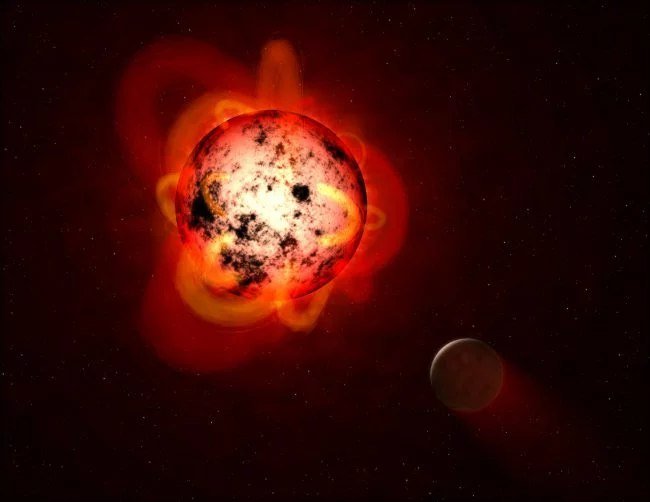
From the report of Eike Gunter from the German Observatory Karl Schwarzschild, presented at a scientific conference held in the framework of the European week of astronomy and space science, it became known that the powerful x-ray radiation resulting from the outbreak at the star AD Leo (aka Gliese 388), could "blow away" the ozone layer from any earth-like planet, which could hypothetically be in this system.
Astronomers are aware of the existence of about 4,000 planets orbiting a variety of stars. At the same time, quite a considerable number of them are earth-like planets located inside the so-called inhabited zones, where their surface can be kept at a favorable temperature suitable for the existence of water in liquid form. However, the majority of candidates samplemodeling wraps around class stars are red dwarfs.
These stars are much smaller and colder than our Sun, and therefore to create suitable living conditions planets need to be closer to such stars. The problem is that, despite the generally calm temperament, red dwarfs are capable of producing very powerful x-ray emissions from time to time, accompanied by coronal mass emissions. Since the "habitable" planets of the red dwarf are relatively close to the star, such outbreaks can pose a serious danger to life arising on their surface. Especially powerful coronal mass ejections can simply "blow off" the atmosphere of the planet.
To accurately the possible consequences of such emissions, the team of Gunter conducted a monitoring of red dwarfs, which could happen such emissions. And in February 2018, scientists have actually recorded one such outbreak on the star AD Leo, also known as Gliese 388 (the outbreak itself, of course, occurred much earlier). Star is 16 light years from us and has 3 million miles (about 15 times closer than Earth is to the Sun) of the giant planet. Scientists are not yet sure, but it is possible that inside this system may be other planets, also located in the inhabited zone, however, to see them with the help of modern devices is not possible.
The first observations showed that, unlike solar flares, the outbreak on the AD Lion was not accompanied by coronal mass emissions. Therefore, the atmosphere closest to the star, the planet and more distant potentially habitable planets should not have to suffer.
However, further data analysis showed that the outbreak was accompanied by strong x-ray emission. It followed from the model built by scientists that such radiation would easily break through the ozone layer of potentially habitable planets, the thickness of which is comparable to the earth's ozone layer, and destroy life on its surface. Moreover, such radiation could destroy most of the ozone layer in just two years. So if there was life on the hypothetical planets of the AD Lion system, it could only survive in the oceans. It's doubtful.
In the future, the research group of Gunter collected on the basis of new observations to make your model more detailed. Some scientists suggest that very large emissions of radiation can in two years deprive any planet 94 percent of its ozone layer, which will lead to the death of all living things. If this claim is true, then count on the opening of the "Earth 2.0" from red dwarf will be premature.
Translated from russian community https://hi-news.ru/research-development/eshhe-odna-zvezdnaya-sistema-byla-sterilizovana-ot-lyuboj-vozmozhnoj-zhizni.html by Damir Koshakrov
Hi! I am a robot. I just upvoted you! I found similar content that readers might be interested in:
https://newsworld.co/another-star-system-was-sterilized-from-any-possible-life/
We're using our limited knowledge to determine where life may be found in the universe. I think she holds a lot more surprises than we currently know. There may, for example, be life present on Jupiter completely adapted to the environment but different from what we know right now. I believe ETL will soon be discovered